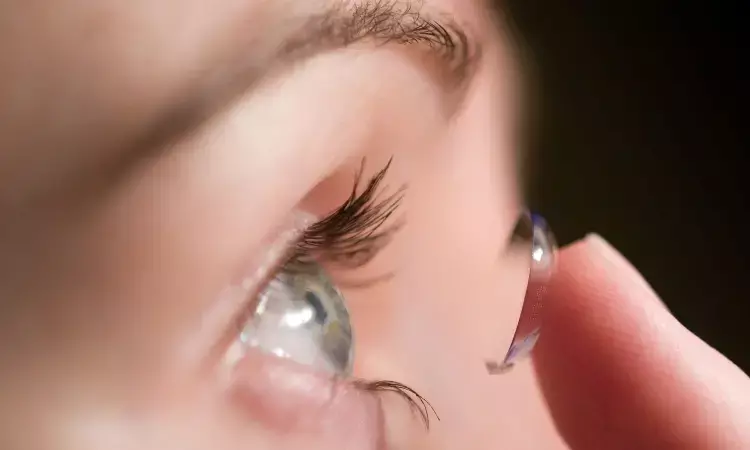- Home
- Medical news & Guidelines
- Anesthesiology
- Cardiology and CTVS
- Critical Care
- Dentistry
- Dermatology
- Diabetes and Endocrinology
- ENT
- Gastroenterology
- Medicine
- Nephrology
- Neurology
- Obstretics-Gynaecology
- Oncology
- Ophthalmology
- Orthopaedics
- Pediatrics-Neonatology
- Psychiatry
- Pulmonology
- Radiology
- Surgery
- Urology
- Laboratory Medicine
- Diet
- Nursing
- Paramedical
- Physiotherapy
- Health news
- Fact Check
- Bone Health Fact Check
- Brain Health Fact Check
- Cancer Related Fact Check
- Child Care Fact Check
- Dental and oral health fact check
- Diabetes and metabolic health fact check
- Diet and Nutrition Fact Check
- Eye and ENT Care Fact Check
- Fitness fact check
- Gut health fact check
- Heart health fact check
- Kidney health fact check
- Medical education fact check
- Men's health fact check
- Respiratory fact check
- Skin and hair care fact check
- Vaccine and Immunization fact check
- Women's health fact check
- AYUSH
- State News
- Andaman and Nicobar Islands
- Andhra Pradesh
- Arunachal Pradesh
- Assam
- Bihar
- Chandigarh
- Chattisgarh
- Dadra and Nagar Haveli
- Daman and Diu
- Delhi
- Goa
- Gujarat
- Haryana
- Himachal Pradesh
- Jammu & Kashmir
- Jharkhand
- Karnataka
- Kerala
- Ladakh
- Lakshadweep
- Madhya Pradesh
- Maharashtra
- Manipur
- Meghalaya
- Mizoram
- Nagaland
- Odisha
- Puducherry
- Punjab
- Rajasthan
- Sikkim
- Tamil Nadu
- Telangana
- Tripura
- Uttar Pradesh
- Uttrakhand
- West Bengal
- Medical Education
- Industry
Rare Case of Traumatic dislocation of iris into vitreous cavity with intact lens

Traumatic aniridia occurs when the iris is extruded from the eye and is often accompanied by lens injuries. Researchers have reported a rare case of Traumatic dislocation of iris into vitreous cavity with intact lens and the same has been published in BMC Ophthalmology.
A 30-year-old man has presented a case of traumatic aniridia due to the dislocation of the iris into the vitreous cavity without any damage to the lens. Traumatic aniridia, a rare condition where the iris is extruded from the eye due to severe injury, is typically accompanied by lens injuries. However, this unique case reported in the BMC Ophthalmology has perplexed ophthalmologists as it marks the first reported instance of traumatic aniridia resulting from iris dislocation into the vitreous cavity while leaving the lens unscathed.
The incident came to light when the patient sought medical attention after sustaining an eye injury from a thin wire. The individual complained of visual impairment and pain shortly after the injury. Medical examinations revealed a full-thickness corneal laceration measuring 2 mm, alongside a complete hyphema, a condition where blood accumulates in the front chamber of the eye. Surprisingly, the lens remained intact, the retina appeared healthy, and the majority of the iris tissue was found within the vitreous cavity after the hyphema resolved.
Further investigations disclosed that the iris had found its path to the vitreous cavity through a defect in the zonule, the fibrous structure that holds the lens in place. This unique course of the iris has baffled experts, as common understanding would expect the iris to be extruded from the eye due to the corneal laceration. Over the course of 50 days, the vitreous cavity began accumulating pigment granules and opacity, prompting the necessity for a vitrectomy – a surgical procedure to remove the dislocated iris.
Medical professionals managing the case highlighted the distinct nature of this occurrence. They emphasized that the specific type of injury, the mechanism of trauma, and the force applied might have collectively contributed to this unparalleled condition. Strikingly, instead of resorting to artificial irises, which are a common solution in cases of aniridia, tinted glasses were deemed a more suitable treatment for the patient.
Additionally, the case underscores the importance of peripheral retinal examination in such situations, aiding in accurate diagnosis and management. This isolated case will undoubtedly encourage further research into the intricacies of ocular trauma and broaden the medical community's understanding of traumatic aniridia.
Reference:
Xie, H.-N., Chen, L.-L., Wang, R., Zhu, Z.-H., & Huang, H.-B. (2023). Traumatic dislocation of the iris into the vitreous cavity with intact lens: a case report. In BMC Ophthalmology (Vol. 23, Issue 1). Springer Science and Business Media LLC. https://doi.org/10.1186/s12886-023-03105-x
Neuroscience Masters graduate
Jacinthlyn Sylvia, a Neuroscience Master's graduate from Chennai has worked extensively in deciphering the neurobiology of cognition and motor control in aging. She also has spread-out exposure to Neurosurgery from her Bachelor’s. She is currently involved in active Neuro-Oncology research. She is an upcoming neuroscientist with a fiery passion for writing. Her news cover at Medical Dialogues feature recent discoveries and updates from the healthcare and biomedical research fields. She can be reached at editorial@medicaldialogues.in
Dr Kamal Kant Kohli-MBBS, DTCD- a chest specialist with more than 30 years of practice and a flair for writing clinical articles, Dr Kamal Kant Kohli joined Medical Dialogues as a Chief Editor of Medical News. Besides writing articles, as an editor, he proofreads and verifies all the medical content published on Medical Dialogues including those coming from journals, studies,medical conferences,guidelines etc. Email: drkohli@medicaldialogues.in. Contact no. 011-43720751


